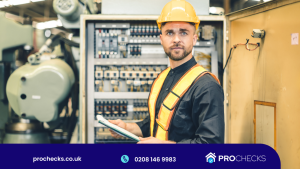EICR certificates, or Electrical Installation Condition Reports, evaluate the safety and condition of electrical systems in properties. These EICR certificates are essential for homeowners to identify potential risks and for landlords to comply with legal obligations, ensuring tenant safety. Conducted by qualified electricians, inspections can uncover wiring defects, grounding issues, and other hazards. Regular assessments support regulatory compliance, extend equipment lifespan, and can result in cost savings. Further insights into EICR Electrical Installation Condition Report Certificates and their significance can enhance understanding.
Key Takeaways
- An EICR certificate assesses the safety and condition of electrical installations, identifying potential hazards in properties.
- Homeowners benefit from EICR certificates as they enhance property value and promote awareness of electrical risks.
- Landlords must conduct EICR inspections every five years and provide tenants with a copy within 28 days of the inspection.
- The EICR inspection process involves engaging a qualified electrician to thoroughly examine electrical systems and document findings.
- Regular EICR inspections ensure compliance with safety regulations and promote cost-effective maintenance, prolonging the lifespan of electrical installations.
What Is an EICR Certificate?
An EICR (Electrical Installation Condition Report) certificate is a formal document that assesses the safety and condition of an electrical installation in a property.

Its significance lies in its role as a diagnostic tool for identifying potential hazards, ensuring compliance with safety regulations.
Despite its critical importance, EICR misconceptions persist; many believe it only serves as a checklist for compliance, overlooking its broader implications for long-term safety and operational efficiency.
EICRs are often misunderstood; they are more than just a compliance checklist, they are vital for long-term safety and efficiency.
Understanding the true scope of an EICR enables property owners and stakeholders to make informed decisions, enhancing both safety and functionality within electrical systems.
Importance of EICR Certificates for Homeowners
EICR certificates play an essential role in safeguarding homeowners from electrical hazards and ensuring compliance with safety regulations.
These certificates promote homeowner awareness regarding the condition of their electrical installations, thereby enhancing electrical safety within residences.
- Identify potential electrical risks before they escalate
- Facilitate informed decision-making regarding repairs and upgrades
- Enhance property value through documented safety compliance
EICR Requirements for Landlords and Rental Properties
While ensuring the safety of tenants, landlords must adhere to specific EICR requirements that govern rental properties.
EICR compliance is essential, as it mandates that landlords conduct electrical safety inspections at least every five years. Additionally, any new tenancies must have a valid EICR certificate before occupancy.
Landlord responsibilities extend to providing tenants with a copy of the EICR report within 28 days of the inspection. Failure to comply can result in penalties and legal ramifications.
Landlords must provide tenants with the EICR report within 28 days to avoid penalties and legal issues.
Therefore, landlords must prioritize these requirements to safeguard tenant welfare and maintain regulatory adherence, ensuring a safe living environment for all occupants.
The Process of Obtaining an EICR Certificate
To obtain an EICR certificate, property owners must first engage a qualified electrician or registered electrical contractor who is competent in conducting the necessary inspections.
The EICR process involves a thorough examination of the electrical systems to identify any deficiencies or hazards. After the inspection, the electrician will complete the certificate application, documenting the findings.
- Confirm the contractor is recognized and accredited.
- Schedule the inspection at a convenient time.
- Review the report carefully to understand any required rectifications.
This systematic approach guarantees compliance with safety standards and helps maintain electrical integrity within the property.
Understanding EICR Ratings and Categories
Understanding EICR ratings and categories is essential for evaluating electrical safety and compliance.
The EICR rating scale categorizes electrical issues based on their severity, providing a clear framework for identifying risks.
Each category reflects the urgency of necessary remedial actions to guarantee safe electrical installations.
EICR Rating Scale
The EICR rating scale serves as a critical framework for evaluating the safety and condition of electrical installations.
Understanding EICR terminology and EICR definitions is essential for professionals conducting these assessments. This scale categorizes findings into distinct ratings, which indicate the level of urgency for remedial actions.
- Rating 1: Immediate danger, requiring urgent remediation.
- Rating 2: Potentially hazardous conditions needing correction.
- Rating 3: No immediate risk but suggests improvements.
These ratings guide stakeholders in prioritizing safety measures and ensuring compliance with regulatory standards, thereby enhancing overall electrical safety and performance.
Categories of Electrical Issues
While evaluating electrical installations, categorizing the various issues identified during an EICR inspection is essential for effective remediation.
Issues are typically classified into critical categories, including faulty wiring and overloaded circuits.
Faulty wiring can lead to hazardous conditions, such as electrical fires or shock hazards, necessitating immediate rectification.
Overloaded circuits, on the other hand, signify excessive current draw, potentially resulting in overheating and equipment failure.
Understanding these categories allows for prioritized intervention, ensuring compliance with safety standards and enhancing overall electrical system integrity.
Mastery of these classifications is crucial for professionals engaged in electrical safety and maintenance.
Frequency of EICR Inspections
How often should EICR inspections be conducted? The frequency guidelines for EICR inspections are vital to maintaining electrical safety.
Typically, the recommended inspection intervals are as follows:
- Residential properties: every 5 years
- Commercial properties: every 3 to 5 years, depending on usage
- Rental properties: every 5 years or at change of tenancy
Adhering to these intervals guarantees compliance with safety regulations and mitigates risks associated with electrical installations.
Compliance with inspection intervals is essential for ensuring safety and reducing risks linked to electrical systems.
Regular EICR assessments provide critical insights into the integrity of electrical systems, fostering a proactive approach to electrical safety management.
Common Issues Detected in EICR Inspections
Common issues detected during EICR inspections often reveal vital deficiencies that can compromise electrical safety. Among the most prevalent findings are wiring defects, which may include frayed cables, loose connections, and improper insulation, leading to potential short circuits or electrical fires.

Grounding issues are also frequently noted, where inadequate earthing can result in shock hazards and equipment malfunction. These deficiencies not only jeopardize user safety but can also lead to system inefficiencies.
Identifying and addressing these problems is essential for maintaining compliance with electrical standards and ensuring the longevity of electrical installations. Proper remediation is vital for ideal operational integrity.
Benefits of Regular Electrical Inspections
Regular electrical inspections offer significant benefits, including enhanced safety measures that mitigate risks associated with electrical hazards.
Additionally, they guarantee compliance with relevant regulations, thereby reducing potential legal liabilities.
Moreover, these inspections can lead to cost-effective maintenance by identifying issues early, ultimately prolonging the lifespan of electrical systems.
Enhanced Safety Measures
Safety is paramount in any electrical system, and the implementation of routine electrical inspections serves as a critical safeguard against potential hazards.
Regular inspections embody preventive measures that align with established safety standards, ensuring the integrity of the electrical infrastructure.
The benefits of these inspections include:
- Early detection of potential faults, minimizing risk
- Assurance that systems are compliant with current safety standards
- Enhanced longevity of electrical installations through timely maintenance
Compliance With Regulations
Ensuring compliance with electrical regulations is a fundamental advantage of conducting regular electrical inspections. Adhering to current standards mitigates compliance challenges that arise from frequent regulatory updates, thereby safeguarding both property and personnel.
Regular inspections facilitate the identification and rectification of deficiencies, enabling organizations to remain aligned with evolving legal requirements. By proactively addressing potential infractions, businesses can avert costly penalties and enhance operational integrity.
Additionally, maintaining compliance through routine assessments fosters a culture of safety and responsibility, ultimately promoting trust among stakeholders. Such diligence reinforces an organization’s commitment to maintaining high electrical safety standards in an increasingly regulated environment.
Cost-Effective Maintenance
A consistent approach to electrical inspections can yield significant cost savings for organizations.
Implementing regular electrical inspections not only guarantees compliance but also promotes effective budget planning through the identification of potential issues before they escalate.
- Preventive measures help mitigate costly repairs.
- Reducing downtime enhances operational efficiency.
- Extended equipment lifespan lowers replacement expenses.










